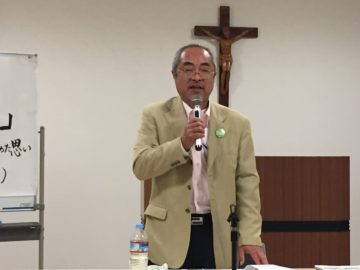As you can imagine easily from the word “voluntary evacuation,” there is little possibility of receiving support from the national and local governments. The situation is quite severe.
Today, I shared my experiences with you. And through the agency of CTVC, we would like to ask for your support.
Thank you very much.
Question: The number of evacuees to Yamagata Prefecture and Tokyo was quite large. Yamagata Prefecture had 13,000 during the most populated period. Roughly speaking, Tokyo had a close number to Yamagata’s.
On the contrary, the number of the evacuees remaining in Yamagata Prefecture is decreasing rapidly now. I think that there are many who returned from Yonezawa to Fukushima. Would you please tell me what you know about the reasons why they had to return, and how they live now, including various difficulties that can be foreseen after their return?
Yunokawa: The number of people who were evacuated to Yamagata Prefecture was around 13,000 in January, 2012. Three years later, it decreased to about 4,000 in March, that is 9,000 less than that of the year 2012.
I think there are two reasons. The first, it is too cold for evacuees from Hamadori, a warm area along the coast of the Pacific Ocean. Yonezawa is known as an area of heavy snow. One to two meter-snowfall is common. It is piled high up around 3 m at the roadside. Snow sweeping is a hard work. You have to wake up early in the morning around five to sweep snow, otherwise you cannot take your car out to drive. Perhaps, I think that they were not accustomed to snow, and were exhausted with it. So, there are some who moved to Iwaki and Soma Cities. If you return to Fukushima Prefecture now, you can borrow a housing again. If so, it is quite understandable for them to move to Iwaki or Soma where the weather is similar with that of their home towns. I heard that there are quite a number of evacuees who have started preparation to build a house in Iwaki and Soma. This is one reason.
Another is that there are voluntary evacuees who feel it hard to live separately: mothers and children live separately from their fathers. As for children, four years after the evacuation, they have reached the age of going to junior high or high schools, and their parents think of returning home. I can’t tell whether they think Fukushima has become a safe place where they can live without worrying about radioactivity.
I think that difficulties the returnees have run into are mainly spiritual. The reason of their evacuation is that they have to live in constant fear of being exposed to radiation. Therefore, returning home means more worries to be added: worries about food, and about their children, for example. I’ve heard that they cannot share their worries with their neighbors who remained in Fukushima, and keep them deep in their minds and hearts. Being together with their fathers now, they might feel relieved.
By the way, the newsletter “Radiation Countermeasures News” of Fukushima City advises the citizens to measure the level of radioactivity of vegetables grown in their gardens and edible wild plants. The radiation standard is set at 100 Bq for food. We are advised not to take foodstuffs containing radioactive substance of over 100 Bq. 67 Bq of radioactive cesium was measured in the bamboo shoots given me by a neighbor at the beginning of May. It was not over the standard, but I didn’t feel like eating them and threw them away. Radiation readings are higher in Koshi abura (a kind of edible young leaves of a certain deciduous tree) and osmunda (royal fern), the former is 1,000 to 2,000 Bq, which is abnormal.
Crops produced in Fukushima undergo careful examination of radioactivity before they are sold at supermarkets. They are cultivated in decontaminated fields. However, the shipment of bamboo shoots and other edible wild plants is still restricted due to high radioactivity. Even if you pick them on a hill behind your house, you cannot ship them for sale. Be sure to measure the radioactive level before you eat. So I’m very much worried about food. Before the disaster, farmers next door used to bring us vegetables gathered in their gardens, or bamboo shoots picked up on a hill behind their houses. However, all these have been lost. After all, they may eat their product by themselves, but cannot share them with others any more. Such continues even now.
Question: Please let us know what you want to tell the people in the Tokyo metropolitan areas.
Yunokawa: For those who live in Tokyo, I wonder whether the nuclear accident has already become an incident of four years ago. It is unavoidable, but the evacuees and those who live in Fukushima are still forced to fight against the nuclear accident and the radiation problems. Advertisements are in the mass media, as a reconstruction campaign, “Come to Fukushima! There are lots of delicious food.” I think I can understand it. But as for me, I wish that everyone would understand that people in Fukushima are still struggling against the nuclear accident and its radioactive effect.
It is children who suffer most. Children are very lively and want to play outside or run around hills and fields to their heart’s content, but they are not allowed to do that any longer. What they are repeatedly told is “Don’t do this.” “Don’t do that.” They are the oppressed. We are doing our best to do what we can for them. I hope that you keep that in your heart. Thank you.

